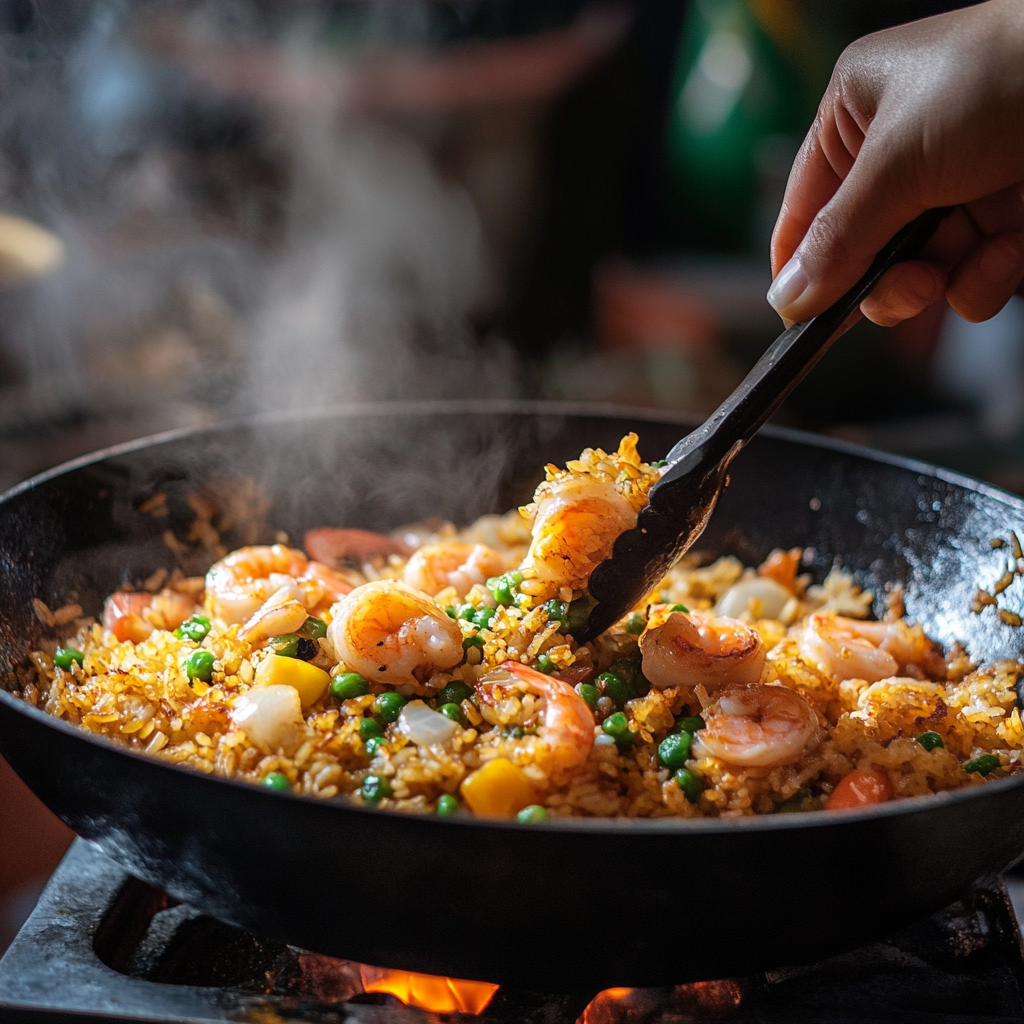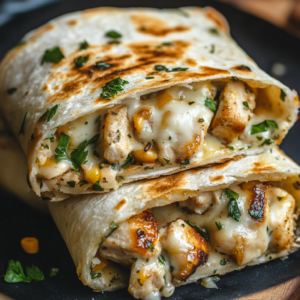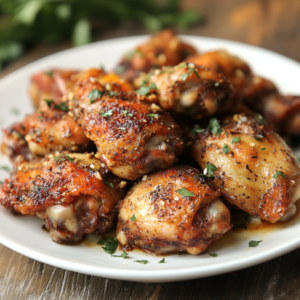Introduction
Fried rice is a beloved dish that has captured the hearts and taste buds of people around the world. This Fried Rice Recipe is not only easy to prepare but also versatile enough to cater to various dietary preferences. Whether you’re looking for a quick weeknight dinner or a delicious side dish for your next gathering, this recipe has got you covered. The beauty of fried rice lies in its adaptability; you can customize it with your favorite proteins or vegetables, making it a fantastic way to use up leftovers.
In this article, we will guide you through every step of creating mouthwatering fried rice. From selecting the freshest ingredients to mastering the cooking technique, you’ll find everything you need right here. With the right approach and a few simple tips, you’ll turn out restaurant-quality fried rice in your own kitchen. So grab your wok or frying pan, and let’s dive into this delightful culinary adventure!
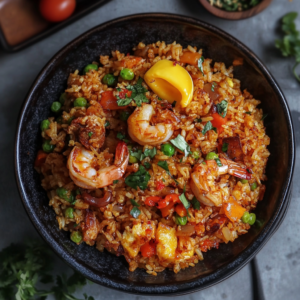
Ingredients
Rice
The foundation of any great fried rice is the type of rice used. Long-grain varieties like jasmine or basmati are excellent choices due to their fluffy texture when cooked. For best results, use day-old cooked rice because it dries out slightly in the fridge and becomes less sticky. This makes it easier to separate grains during frying. Aim for about 4 cups of cooked rice for this recipe. If you’re cooking fresh rice, allow it to cool completely before using.
Vegetables
A colorful mix of vegetables adds both nutrition and vibrancy to your fried rice. Common options include peas, carrots, bell peppers, and green onions. You can use about 1 cup each of diced carrots and bell peppers along with ½ cup frozen peas. Feel free to experiment with other vegetables like corn or broccoli based on what you have on hand. Ensure they are chopped into small pieces so they cook quickly and evenly.
Protein
Adding protein enhances the heartiness of your dish. You can choose from chicken, shrimp, tofu or even scrambled eggs depending on your preference. For this recipe, about 1 cup of cooked chicken (diced) works well; however, feel free to adjust based on your serving needs or personal taste.
Soy Sauce
Soy sauce is crucial for imparting that classic umami flavor to your fried rice. Use around 3 tablespoons of soy sauce for this recipe; adjust according to taste preference. Consider using low-sodium soy sauce if you’re watching your salt intake.
Oil
Using the right oil can make a significant difference in frying quality. Opt for oils with high smoke points like canola or peanut oil—about 2 tablespoons will suffice for sautéing all ingredients without burning them during cooking.
How to Prepare Fried Rice Recipe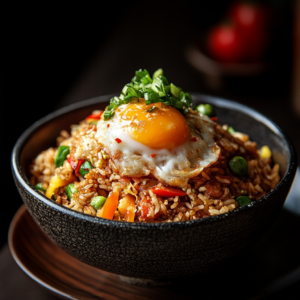
Step 1: Prepare Your Ingredients
Before diving into cooking your delicious fried rice recipe, it’s essential to prep all your ingredients thoroughly. Start by ensuring that your day-old cooked rice is ready; break up any clumps using a fork so that each grain is separate when frying. Next, chop all vegetables into small pieces—this ensures they cook evenly and integrate well into the dish.
If you’re adding protein like chicken or shrimp that needs cooking before incorporation into the stir-fry process, do so now as well; ensure they are chopped into manageable bite-sized pieces too! Finally, gather all ingredients within arm’s reach beside your stove so that you can easily toss them in as needed during cooking.
Step 2: Heat the Wok
Now that everything is prepped let’s get started with frying! Place your wok over medium-high heat until it’s hot; ideally wait until there’s slight smoke coming off its surface before adding oil—a clear sign it’s ready for cooking action! Pour in two tablespoons of oil and swirl around quickly while coating the bottom surface evenly.
Once heated sufficiently (this should take just a minute), add diced protein first if you’re including meat or seafood—cook thoroughly until golden brown on all sides before removing them from the pan onto a plate temporarily while keeping an eye on residual heat inside!
Step 3: Stir-Fry Vegetables
With proteins set aside momentarily on one side bring back attention towards our chopped veggies! Add another tablespoon of oil if necessary followed by all prepared vegetables straight into sizzling hot wok—stirring constantly helps maintain even distribution across every ingredient! Cook these vibrant colors together until softened slightly (around 3-5 minutes), ensuring they retain some crunchiness for texture purposes throughout final dish assembly later!
Once done transfer them directly alongside already-cooked proteins waiting patiently off-screen earlier—give everything another good toss together allowing flavors meld harmoniously throughout each morsel involved!
Step 4: Incorporate Rice
It’s time now folks—the moment we’ve been waiting for has arrived! Gently introduce cooled day-old cooked rice directly into our bubbling medley previously created within wok! Using spatula break apart any stubborn clumps still lingering while ensuring an even distribution across entire surface area available without overcrowding either party involved here!
After achieving desired consistency pour in soy sauce evenly drizzling across mixture—don’t forget seasoning adjustments based upon personal preference at this stage too if needed (more soy? less?). Continue tossing vigorously until heated through entirely (around another 5 minutes)—this allows those delicious flavors fully penetrate every single grain present here!
Serving and Storing Tips
Serving Suggestions
Fried Rice is incredibly versatile when it comes down to serving ideas! It can be enjoyed alone as a main course or paired alongside Asian-inspired dishes like sweet-and-sour chicken or teriyaki salmon—it truly complements various flavors beautifully due its rich umami profile found naturally within itself already!
For presentation purposes consider garnishing plates with freshly chopped green onions or sesame seeds atop finished servings—a splash of color always elevates visual appeal significantly while also providing extra crunch factor upon enjoyment itself later!
Storage Guidelines
To store leftover fried rice properly ensure it cools completely first before placing inside airtight containers—this prevents moisture buildup which could lead spoilage during refrigeration process thereafter! Once sealed securely place container within fridge where leftovers should remain fresh up-to three days maximum without issue occurring.
Reheating leftover portions requires just short time spent warming over stovetop once again—adding splash of water helps steam through dry areas making sure taste remains intact without losing original texture found initially upon creation earlier too! Enjoy those leftovers just as much second time around knowing how simple yet satisfying making this fabulous Fried Rice Recipe truly was overall!
Mistakes to avoid
When making a fried rice recipe, there are several common mistakes that can lead to a disappointing dish. One of the most significant errors is using freshly cooked rice. Fresh rice contains too much moisture and can become mushy when stir-fried. Instead, use day-old rice that has been refrigerated. This allows the grains to firm up and makes them easier to separate during cooking.
Another mistake is overcrowding the pan. When you add too many ingredients at once, the temperature of the pan drops, causing steaming instead of frying. To achieve that desirable crispy texture, cook in small batches. This ensures that each grain gets enough heat and develops a nice golden color.
Using the wrong type of oil can also ruin your fried rice experience. Oils with low smoke points will burn and impart an unpleasant taste to your dish. Opt for oils like vegetable, canola, or peanut oil, which can withstand high temperatures without losing their flavor.
Lastly, neglecting to season properly can leave your fried rice bland. Soy sauce is essential for flavor, but adding it too early can lead to sogginess. Drizzle it toward the end of cooking for a better result. Additionally, remember to taste and adjust seasoning as needed throughout the cooking process.
Tips and tricks
To elevate your fried rice recipe, start with the right ingredients. Choose high-quality vegetables and proteins that you enjoy. Freshness matters; using seasonal vegetables enhances both flavor and nutrition. Consider adding colorful bell peppers, carrots, or peas for a vibrant dish.
Another effective tip is to pre-cook any proteins you plan to use before adding them to the rice. Whether it’s chicken, shrimp, or tofu, pre-cooking allows you to better control their doneness and texture in the final dish. Cut proteins into small pieces for quicker cooking times.
Utilizing various sauces can significantly enhance your fried rice recipe’s depth of flavor. In addition to soy sauce, consider using oyster sauce or sesame oil for extra richness. A touch of chili paste can also introduce a pleasant heat if desired.
Don’t forget about garnishes! Chopped green onions or cilantro sprinkled on top adds freshness and visual appeal. For an extra crunch, consider topping with toasted sesame seeds or crushed peanuts just before serving.
Finally, serve your fried rice immediately after cooking for the best taste and texture. Allowing it to sit may result in sogginess as steam continues to cook the ingredients even off heat.
Suggestions for Fried Rice Recipe
When crafting your fried rice recipe, think beyond traditional flavors by experimenting with different cuisines. For instance, try incorporating elements from Thai cuisine by adding basil and lime juice for a unique twist on this classic dish.
Consider making vegetarian or vegan versions by omitting animal products altogether while ensuring adequate protein intake through legumes like edamame or chickpeas. This approach not only caters to dietary preferences but also introduces exciting new flavors.
If you’re looking for a heartier meal option, consider adding eggs scrambled directly into the dish during cooking. This adds protein while enriching the overall flavor profile without needing additional ingredients.
It’s also beneficial to adjust your fried rice recipe based on dietary restrictions or preferences within your household—gluten-free soy sauce options are available for those avoiding gluten while still enjoying this delicious meal.
Lastly, always keep portion sizes in mind when preparing your fried rice recipe. It’s easy to make too much food when cooking in bulk; consider storing leftovers properly in an airtight container for later enjoyment without sacrificing quality or taste.
FAQs
What type of rice is best for fried rice?
The best type of rice for a fried rice recipe is day-old jasmine or long-grain white rice due to its firmer texture after refrigeration. Freshly cooked rice tends to be sticky and clumps together rather than achieving that distinct non-sticky texture we love in fried rice dishes.
Can I add other proteins besides chicken in my fried rice?
Absolutely! You can customize your fried rice recipe by incorporating various proteins such as shrimp, pork, beef, tofu, or even plant-based alternatives like tempeh or seitan for added flavor and nutrition depending on personal preferences and dietary needs.
How do I store leftover fried rice?
To store leftover fried rice properly after preparing your dish: allow it cool entirely before transferring it into an airtight container. Refrigerate within two hours of cooking; ideally consume leftovers within three days for optimal freshness while reheating thoroughly before serving again!
Can I make fried rice ahead of time?
While it’s recommended to enjoy freshly made fried rice immediately for the best texture and flavor experience; if needed you can prepare components ahead (like chopping veggies) then simply combine everything quickly when ready—this cuts down prep time significantly while maintaining quality!
Conclusion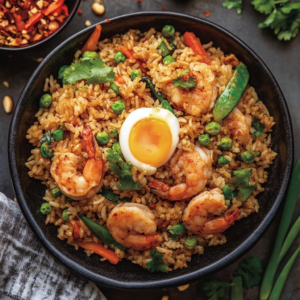
In summary, mastering a delicious fried rice recipe requires attention to detail and avoiding common pitfalls such as using fresh instead of day-old rice or overcrowding the pan during cooking. By implementing tips like pre-cooking proteins and experimenting with flavors through sauces and garnishes, you can elevate this classic dish into something extraordinary.
Don’t forget about dietary preferences—your recipe should cater not just to tradition but also accommodate various tastes within your household while ensuring everyone enjoys their meal without compromise! Remember that proper storage techniques help maintain quality when saving leftovers so nothing goes wasted either.
By keeping these key points in mind along with creative suggestions on how best utilize ingredients available around you—creating memorable meals becomes straightforward while allowing room for innovation every time you whip up this beloved comfort food staple!
